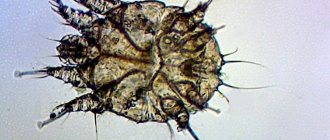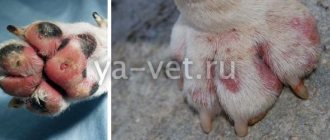Scabies is a skin problem that affects many animals, including cats, but it is not a disease. Mange is caused by tiny parasites called mites that bite your pet's skin and cause itching, flaking, hair loss and inflammation.
Scabies is a special type of skin disease associated with the Sarcoptes mite that causes sarcoptic mange.
Scabies is uncommon in cats, so owners don't always recognize it right away. But this disease is highly contagious and can be passed between pets, so it is important to treat ticks as soon as possible.
There are several medications that can effectively get rid of scabies. Your veterinarian can help you determine the best option for your cat.
Causes of mange in cats
The cause of the disease is the active activity of the Notoedres cati tick. These parasites can cause the most severe infectious skin diseases. They live in the lower layers of the dermis, feeding on skin particles and lymph. This is where they lay their eggs. In one day, 1 female tick is capable of laying from 2 to 8 eggs, and in her entire life - about 20 eggs.
Ticks have a spherical shape, the color of the body is gray. The length of the parasite is about 0.14-0.45 mm. It has small suction cups on its paws, which it uses to cling to the animal.
Scabies mites in cats may not always cause the development of the disease. The most susceptible to this are:
- emaciated animals;
- cats with reduced immunity;
- young animals;
- have not undergone special antiparasitic treatment.
Most often, scabies is only a secondary disease. Therefore, its appearance may indicate the presence of more severe disorders in the cat’s body.
Division into types depending on the pathogen
Symptoms and treatment for mange in cats depend on the type of mite. According to this criterion, 4 types of disease are distinguished.
Otodectosis
The causative agent is the tiny ear mite Otodectes cynotis. The maximum size of its body is only 0.75 mm. It affects the outer and inner parts of the ear. Distinctive signs of otodectosis are severe ear itching, the appearance of a nauseating smell of rot and dark grains inside the ears. An infected cat constantly shakes its head and rubs its ears against any objects.
Demodicosis
Demodex canis is a cigar-shaped parasite that is light gray in color. The length of its body is 0.2-0.3 mm. Unlike other pathogens, it lives in the sebaceous glands and hair follicles from the moment the animal is born. The development of demodicosis occurs with a sharp drop in immunity.
According to the degree of damage, there are 2 forms: localized and generalized. In the first case, the diameter of the lesions is no more than 2.5 cm, in the second, the disease affects most of the body. The localized form often goes away on its own and responds well to drug therapy. The chance of recovery from chronic demodicosis depends on the complications that arise. When a secondary infection occurs, they drop to 50%.
Depending on the symptoms, demodicosis can be scaly or pustular. In the first case, redness and cracking of the skin is noted, in the second - the appearance of suppuration and ulcers. The danger of generalized demodicosis is in the combination of scaly and pustular forms. The disease is accompanied by severe complications and is difficult to treat.
Sarcoptic mange
Sarcoptes scabiei is a broad-oval tick that is white-yellow or completely white. The length of the smallest representatives is 0.14 mm. They affect the entire surface of the body and cause sarcoptic mange. You can suspect their appearance by thin light gray lines with a small bubble at the end that appear on the affected areas.
Notoedrosis
Notoedres is a round, dirty gray parasite. The length of its body is 0.5-0.45 mm. Most often it affects the outer side of the ears. In this case, dark gray discharge with a foul odor appears from the ears. Due to liquid secretions, the fur sticks together and takes on an unkempt appearance. The disease is called pruritic scabies, or notoedrosis.
Symptoms
The owner of the animal can recognize the unpleasant disease on his own. Signs of scabies in a cat are as follows:
- Severe itching. This is the main symptom of the disease. First, the cat feels itching in the ears and neck. Discomfort occurs as a result of the fact that the tick digs its way into the thickness of the skin, where it subsequently lays eggs. Because of this, the cat begins to shake its head, trying to shake off the parasite, scratches constantly, becomes restless, can be aggressive and stops eating. PHOTO
- Scratches and scratches occur due to frequent scratching, which can sometimes be obsessive. PHOTO
- Hair falls out in the affected areas, and dark crusts are clearly visible on the surface of the skin. First, hair loss begins at the edges of the ears, gradually the problem moves to the forehead and neck. If treatment is not started in time, hair loss can be general and affect the entire body of the animal. PHOTO
- At the place where the tick pierced the skin, there is a hard bump with a diameter of up to 10 mm. A small hole is visible at its top. If you press on the tubercle, a white thick liquid will be released from the hole. The skin around the lump is red and scaly. PHOTO
- Nodules may appear on the skin, which subsequently fester. PHOTO
Routes of infection
The most common route of infection with cat scabies is contact. The microscopic tick can easily jump from one infected animal to another. Moreover, it is absolutely not necessary to contact sick relatives. A cat can become infected from a dog, from another cat, or from birds - domestic or wild. Pigeons are especially prone to scabies.
This can happen anywhere: during a walk, at a veterinarian’s appointment, at an exhibition, on public transport. Small kittens often become infected from their sick mother during the period of cohabitation and feeding.
The second common route of transmission of parasites is through animal care items. You can pick up a tick from someone else's comb, brush, or bedding. The third is housekeeping clothes and shoes. A person can bring ticks into the house on their clothes or shoes.
Who is at risk
Most often people become infected with scabies:
- Animals with weakened immune systems.
- Exhausted cats.
- Pets in shelters and stray cats.
Diagnostics
Scabies in a cat brings severe discomfort to the animal's life. Also, a sick animal can cause illness to other pets in the house and people who come into contact with it. The cat needs to be shown to a specialist and treatment started on time. A full diagnosis should be carried out to exclude other skin diseases (for example, lichen or dermatitis).
In most cases, an external examination of the cat and a medical history is sufficient for the veterinarian to make a diagnosis. But to determine the type of mite and draw up an optimal treatment regimen, you need to scrape the deep layers of the skin.
Disease prevention
Preventing scabies is easier than dealing with it and its consequences. The following actions are taken as preventive measures:
- regularly treat the fur of cats and cats against ticks, fleas and other parasites (once every six months);
- clean toys, wash bedding and bed covers;
- bathe the cat after a walk or wipe it with a damp cloth;
- before being released outside, put on an insecticidal collar;
- Periodically bring the cat to the veterinarian for examination.
If an animal becomes infected, it is isolated from other pets and family members. Household items that the sick cat has come into contact with are burned or frozen, and all surfaces are disinfected.
Treatment of scabies in cats
Treatment of scabies should begin with isolating the animal. This will help prevent family members and other animals from becoming infected. After this, use the medicine prescribed by your doctor. It can be in the form of injections, drops or ointment.
Additionally, the owner can alleviate the animal’s condition by washing away dead epidermis, fallen hair, and crusts of dried blood. This should be done as carefully as possible and in protective clothing.
Treatment of notohedrosis
Before using medications, it is necessary to remove hair from the outer part of the ears in the affected area. The second step is to bathe the cat with shampoo that contains acaricidal components. In the early stages, you can treat your pet with local remedies. Aversectin or novertine ointment is suitable for this; they are applied twice a week. An alternative may be Demos gel, the frequency of its use is once every four days.
global $ads_google; //data-ad-slot=”2475549904″ $ads_google = empty($ads_google) ? false : true; ?> if ($ads_google == false) {?>
$ads_google = true; ?> } ?>
For systemic treatment of feline scabies, injections of drugs based on ivermectin (1%) are prescribed - five injections every five days. The therapy includes Stronghold drops with selamectin or Advocate, they are used every three weeks.
Scabies injections
Only special scabies injections can eliminate mites that are located deep in the skin. For the treatment of cats the following are prescribed:
- Ivermectin. The drug has a broad antiparasitic effect; its use leads to paralysis and then death of ticks. Careful dosage is required as the composition is toxic to cats. PHOTO
- Baymek. It has a long-term antiparasitic effect and disrupts the nervous system of parasites. It is administered subcutaneously, and it is recommended to distribute the required amount of the product into several injections, which must be given in different places. PHOTO
- Novomek. The active ingredient is ivermectin. It has a systemic and contact effect on ticks, affects the release of gamma-aminobutyric acid, which provokes a block in the transmission of nerve impulses, resulting in tick paralysis. The product is non-toxic and harmless to cats, provided the dosage is followed. PHOTO
Are animal scabies mites dangerous for humans?
The causative agent of scabies is the itch mite, invisible to the ordinary eye. This highly contagious disease affects not only people, but also pets, including cats.
Owners who let their pets roam freely often wonder whether it is possible to get scabies from an animal.
This disease is not so common in four-legged murks, but owners should know the peculiarities of the disease and how it differs from the human species.
How does scabies appear in cats?
Invasive scabies infection in the cat family is fundamentally different from the human disease caused by a parasitic mite.
An accurate diagnosis can only be made by a veterinarian based on a visual examination of the animal and the results of skin scraping analysis.
The specialist will determine the type of scabies parasite, explain safety measures for the owner and prescribe treatment for the pet. There are three types of ticks in cats:
- Cheyletiellosis (scientific name Cheyletiella) - can be transmitted to humans, lives on the entire surface of the animal’s body.
- Notoedres - starts in the head area, provokes the formation of purulent crusts and hair loss. Can be transmitted to humans.
- Red-bodied tick (Trombicula) - chooses to live on the hind limbs of the body of cats, and can also be transmitted to humans.
In the initial stage, scabies appears in the neck, head and ears of the pet. Over time, the parasites spread over the entire surface of the animal’s body and lay eggs. In this regard, the aching itch worries the pet more and more, scratches and wounds appear on the skin, and the hair in these places falls out. In cats, scabies is accompanied by the following symptoms:
- increased anxiety and nervousness;
- refusal of usual food and water;
- aggressive behavior for no apparent reason;
- severe itching and increased scratching;
- hair loss;
- the appearance of purulent scratches on the surface of the skin.
If timely assistance is not provided, the disease progresses and the animal’s general condition becomes noticeably worse. Individuals with reduced immunity who have undergone a serious illness or surgery are at greater risk. In such cases, scabies may appear again and be more severe.
Diagnosis and treatment
To accurately determine the type of tick, a specialist must scrape it and send it for analysis. This is done in order to exclude diseases with similar symptoms - eczema, allergies, dermatitis or lichen.
Drug therapy for a four-legged patient lasts on average from one to three weeks. Special shampoos, sprays, ointments, as well as oral medications of various forms (drops, syrups, tablets) are used as treatment.
The approximate treatment formula looks like this:
- treating the affected surface with a gentle antiseptic - hydrogen peroxide, miramistin, chlorhexidine;
- taking antibiotics to prevent the risk of developing a secondary infection;
- use of acaricides to control insects;
- taking antihistamines to relieve itching;
- stimulating the work of immune cells with the help of vitamin complexes.
Particular attention should be paid to antiparasitic treatment. The dosage and drug should be determined by the doctor, taking into account the health characteristics of a particular animal. The effectiveness of the prescribed therapy will depend on the accuracy of the procedures recommended by the specialist. Even skipping a medication once will delay the healing process indefinitely.
How is scabies transmitted to humans?
For infection from a sick animal, ordinary contact is sufficient. For example, a child who pets a stray animal on the street becomes a carrier of scabies mites. Infection can also occur if a free-ranging pet brings parasites home. However, not all types of cat scabies are dangerous to humans, among them:
- Hair mites are able to survive exclusively in animal fur; human skin is not suitable for their life and reproduction.
- Parasites that can live on the human body for no more than two days - in this way, insects only move long distances and, not finding a more suitable host, die.
- Small mites that appear during the period when the cat’s immune system is weakened are relatively harmless to a healthy person.
In medical circles, there is a special term that characterizes infection from a cat to a person - “pseudo scabies.”
The fact is that ticks that carry invasive diseases can only comfortably exist on a cat’s body. Parasites can only stay on human skin for a short time, causing discomfort.
Despite their apparent harmlessness, scabies mites can cause a lot of trouble, for example:
- feeling of discomfort;
- dryness and severe peeling of the skin;
- pimples and ulcers;
- cortical formations.
Pseudo scabies is not transmitted between people and goes away on its own, without medical intervention. If the above symptoms cause severe concern, you should consult a dermatologist.
Can a cat get infected from a person?
If a person can become infected with scabies from a four-legged friend, then the question is quite logical: does the opposite happen? The “human” scabies mite is physically incapable of surviving on the body of any animal, be it a cat, dog or hamster. However, pets can act as a means of transport or temporary shelter for such parasites. Thus, if an animal has been in contact with an infected person, then there is a risk of infection of its owner.
Antiparasitic treatment of fur and paws reduces the risk of your pet becoming a carrier of an unpleasant disease. There are a wide variety of sprays, drops and collars that protect against any pests. Before each walk, treat the surface of your cat’s body with a special product, and also regularly visit your veterinarian for a checkup.
Preventive methods of controlling parasites
It is better to prevent any disease than to treat it, but it is impossible to isolate yourself from the whole world. Even if your pussy sits at home, you can infect it by bringing mites on your clothes or the soles of your shoes. Compliance with preventive measures includes:
- Minimizing contact with stray animals;
- Balanced nutrition for the pet - dry food should be at least premium, and homemade food only from high-quality products;
- Regular examination of the animal's fur and skin - first of all, the groin area, ears, armpits;
- Maintaining hygiene - cleaning bowls, toys and beds.
- Cat breeders should not separate kittens from their mother for up to two months - along with milk, the offspring receive passive immunity, which protects the animal from pathogenic organisms.
It is advisable to sterilize pets who have recovered from the disease in order to avoid hormonal imbalances, complicated by relapses in the future. If a cat is carrying kittens and at the same time has contracted scabies, there is a possibility of giving birth to offspring with pathologies. Compliance with hygiene rules and basic prevention will reduce the risk of infection for your pet.
Drops for scabies
Tick drops are only an additional treatment method. Treatment of cats should be comprehensive with the use of injectable antibiotics. The following are used as external agents:
- Neostomazan - affects the central and peripheral nervous system of arthropods, has a prolonged effect, can be used to wet or bathe the animal, for which the drug is diluted in water (the recommended doses will be advised by the veterinarian), the treatment of the animal is repeated after 10 days;
- Amitrazine is a drug with an acaricidal effect, it is active against the larvae and sub-adult phases of parasite development, the death of the latter is possible due to disruption of their motor activity and paralysis;
- Butox is a broad-spectrum drug, has an oily structure, dissolves well in water, is active against various types of mites, including scabies, and can accumulate in the body (in the ganglia of peripheral nerves) of arthropods, which inhibits their motor activity, and can used for spraying or bathing the animal.
Diagnosis and treatment
To accurately determine the type of tick, a specialist must scrape it and send it for analysis. This is done in order to exclude diseases with similar symptoms - eczema, allergies, dermatitis or lichen. Drug therapy for a four-legged patient lasts on average from one to three weeks. Special shampoos, sprays, ointments, as well as oral medications of various forms (drops, syrups, tablets) are used as treatment. The approximate treatment formula looks like this:
- treating the affected surface with a gentle antiseptic - hydrogen peroxide, miramistin, chlorhexidine;
- taking antibiotics to prevent the risk of developing a secondary infection;
- use of acaricides to control insects;
- taking antihistamines to relieve itching;
- stimulating the work of immune cells with the help of vitamin complexes.
Particular attention should be paid to antiparasitic treatment. The dosage and drug should be determined by the doctor, taking into account the health characteristics of a particular animal. The effectiveness of the prescribed therapy will depend on the accuracy of the procedures recommended by the specialist. Even skipping a medication once will delay the healing process indefinitely.
Ointment for scabies
Elimination of symptoms and treatment at home is possible. The following are used as local therapy:
- Ointments and lotions based on tar or sulfur.
- Sea buckthorn oil.
- Pikhtoin. Has a complex anti-inflammatory effect. After application, the product penetrates through the glands and partially into the intercellular passages, then becomes soluble and is absorbed by the body. Apply a thin layer, after which it is recommended to apply a gauze bandage.
- Avermectin paste is rubbed against the grain in places where insects accumulate and on the back of the head. For ease of use, it can be melted. The procedure must be repeated after 7-10 days, but if the affected area of the animal is large, then the frequency of application of the product is increased.
These products help eliminate skin inflammation and restore its protective functions. But they must be used with extreme caution, since there is a high risk of the product getting inside, which can lead to intoxication. Therefore, it is recommended to purchase and constantly use a special cone-shaped collar. It will prevent the product from being licked off.
Is scabies contagious to humans?
The question of whether scabies is transmitted to humans or not worries every owner of a fluffy cat. The disease is considered contagious and can spread to other animals and humans. These parasites cannot live outside a living organism; they definitely need a host. However, scabies mites, having penetrated the epidermis of human skin, cannot exist in it for a long time. Symptoms of infection with sarcoptic mange or notoedrosis look like an allergy. In rare cases, otodectosis can cause otitis externa.
global $ads_google; //data-ad-slot=”2475549904″ $ads_google = empty($ads_google) ? false : true; ?> if ($ads_google == false) {?>
$ads_google = true; ?> } ?>
Human skin is too dense for scabies mites; they cannot lay eggs in it or move around. This feature saves a person from cat scabies. In the short period while the ectoparasite is in the upper layers of the dermis, it causes itching and discomfort. After spontaneous healing, the symptoms disappear. Despite these features, when treating a sick cat, the owner must observe personal hygiene measures:
- use gloves when handling your pet;
- wash your hands with soap after treatment procedures;
- boil things that the cat has come into contact with;
- Regularly vacuum carpets and wash floors in the house.
Scabies mites disappear from the human body in less than a month.
Can you get scabies from a cat?
The question of whether it is possible to become infected from an animal haunts many owners. Scabies can be transmitted from a cat to a person through contact with a sick animal. The causative agents of the disease cause a red rash on the host's skin, which is similar to mosquito bites. The mite can infect the skin of the legs, arms, thighs, chest, and abdomen.
In this case, there cannot be a strong infection due to the inferiority of the life cycle of mites without the original host, but the resulting irritation on the skin can be extremely unpleasant. The itching goes away only within 2-3 weeks after complete isolation of the animal. Additionally, you can consult a doctor to prescribe a drug to eliminate unpleasant symptoms.
Risk factors
The stronger the cat’s immunity, the greater the likelihood that he will cope with the parasite on his own, because not all animals that come into contact with scabies mites get sick. There are several factors that can increase your risk of infection. These include:
- damage to the skin (wounds, scratches, ulcers);
- close contact with sick cats, cats and other animals;
- weakened immunity due to recent surgery, treatment with antibiotics or hormonal drugs;
- the presence of helminths or external parasites (fleas, ticks, lice);
- unbalanced, insufficient calorie diet;
- age younger than two years or older than eight.
It should be noted that British and Siamese cats and male cats are slightly more likely to develop mange than other breeds. This is explained by the individual characteristics of their body.
Preventive measures
Scabies in cats can be prevented by regularly examining the animal yourself or taking it to the veterinarian once every 3 months. There are other preventive measures that will help avoid the disease:
- do not let the cat out of the apartment;
- if the animal cannot live without walks, then regularly use special products against fleas, ticks and worms;
- include vitamins in the cat’s diet if the animal does not eat special food;
- strengthen immunity;
- wash your cat's dishes thoroughly;
- follow the rules of caring for your pet, regularly bathe the animal using special shampoos, even if it does not go outside, because fleas and ticks can be carried into a person’s house on shoes and clothes.
If the cat has already been diagnosed with this disease, then in order to prevent relapse, injections of Immunoparasitan are recommended every 3-6 months. The action of this drug allows you to increase the body’s protective functions and prevent re-infection.
All information posted on the site is provided in accordance with the User Agreement and is not a direct instruction to action. We strongly recommend that before using any product, you must obtain a face-to-face consultation at an accredited veterinary clinic.
Preventive methods of controlling parasites
It is better to prevent any disease than to treat it, but it is impossible to isolate yourself from the whole world. Even if your pussy sits at home, you can infect it by bringing mites on your clothes or the soles of your shoes. Compliance with preventive measures includes:
- Minimizing contact with stray animals;
- Balanced nutrition for the pet - dry food should be at least premium, and homemade food only from high-quality products;
- Regular examination of the animal's fur and skin - first of all, the groin area, ears, armpits;
- Maintaining hygiene - cleaning bowls, toys and beds.
- Cat breeders should not separate kittens from their mother for up to two months - along with milk, the offspring receive passive immunity, which protects the animal from pathogenic organisms.
It is advisable to sterilize pets who have recovered from the disease in order to avoid hormonal imbalances, complicated by relapses in the future. If a cat is carrying kittens and at the same time has contracted scabies, there is a possibility of giving birth to offspring with pathologies. Compliance with hygiene rules and basic prevention will reduce the risk of infection for your pet.
Treatment at home
To effectively combat ticks, it is necessary to understand that treatment must be comprehensive and take at least three weeks. At the same time, every pet that is in the apartment must undergo examination and appropriate prevention. It is necessary to reduce the likelihood of re-infection and re-infection. As for treatment methods, they include the following techniques:
- Bathe your pet daily using antiparasitic drugs, usually lime sulfur.
- Alternative treatment. It involves the use of Ivermermectin once every 14 days for three procedures. Certain types of cats, usually Siamese, react negatively to the active substances in Ivermectin, so this treatment often does not give good results.
- Revolution. The medication comes in the form of drops or ointments and is an effective monthly treatment for your pet to prevent heartworms, fleas and other parasites. In addition, the drug can fight scabies mites, eliminating the consequences of chronic sarcoptic mange.
- Treatment with antibiotics. Such drugs are effective in the development of secondary bacterial infection and aggravation of symptoms.
- Regular cleaning, which includes vacuuming and washing clothes. This action is considered preventive, as it helps prevent the appearance of scabies mites in the house, protecting residents and pets from these annoying parasites.
As for external preparations, including drops on the withers, they are practically useless, since they do not give visible results. Therefore, when choosing treatment methods, it is better to give preference to more effective options.
In most cases, scabies mite control is carried out at home. In this case, the pet owner is forced to wash the cat weekly, applying antiparasitic drugs containing sulfur to the coat.
However, self-medication without first consulting a trained veterinary professional is not recommended. This approach can only worsen the pet’s condition and lead to fatal consequences.
As for sulfur-containing products, they are completely harmless, although they pose a threat to household items and can damage acrylic surfaces and porcelain. Such objects quickly become yellowed and begin to deform. In addition, sulfur is a mineral element with a specific odor that resembles the smell of “rotten eggs.” Therefore, when performing processing operations it is necessary to wear gloves.
It is better to carry out bathing procedures outdoors, not allowing the animal to return indoors until it is completely dry. This measure will protect furniture and carpet surfaces from being stained yellow. And to avoid damage to the conjunctival mucosa, you may have to use eye drops.
It is known that ticks are not able to live long in the environment. Therefore, regular cleaning of textiles and soft surfaces, vacuuming and washing clothes is the best prevention of such a dangerous problem. At the same time, we must not forget that the scabies mite poses a threat to people, so when caring for an infected cat, you need to remember about personal safety.
As for the prevention of sarcoptic mange, it involves preventing the interaction of healthy pets with infected ones. And although the life expectancy of a parasite in the environment is very short, upon contact with another favorable creature it will certainly lead to the development of the disease. When faced with sarcoptic mange, it is necessary to carefully examine all pets at a veterinary clinic.











